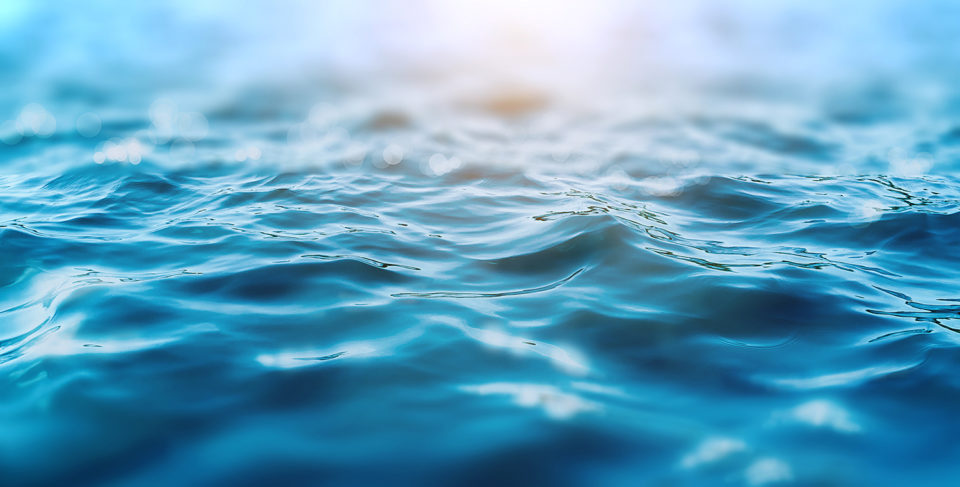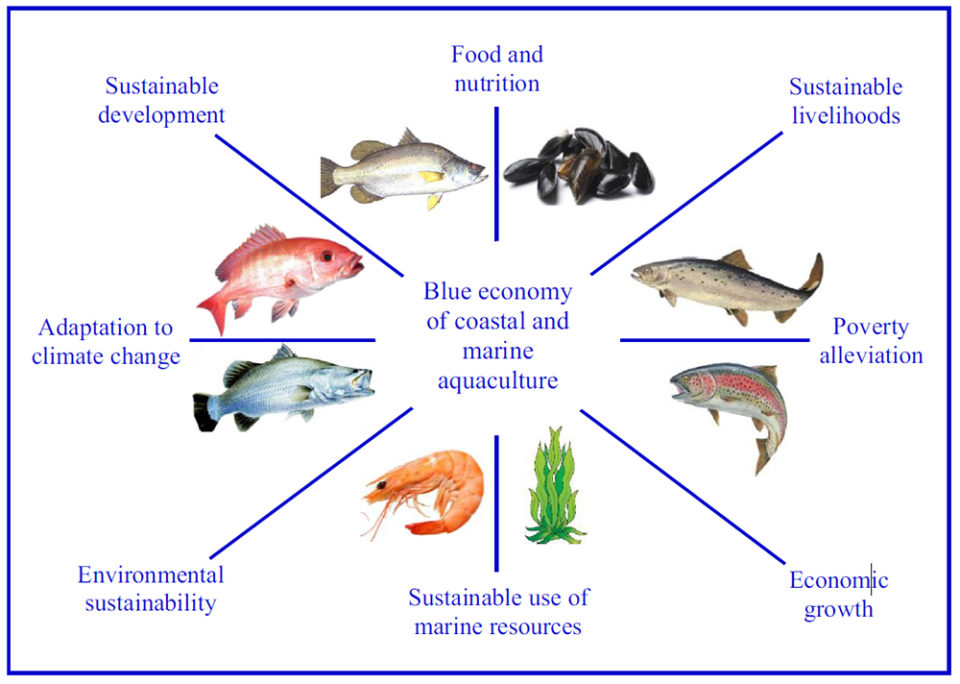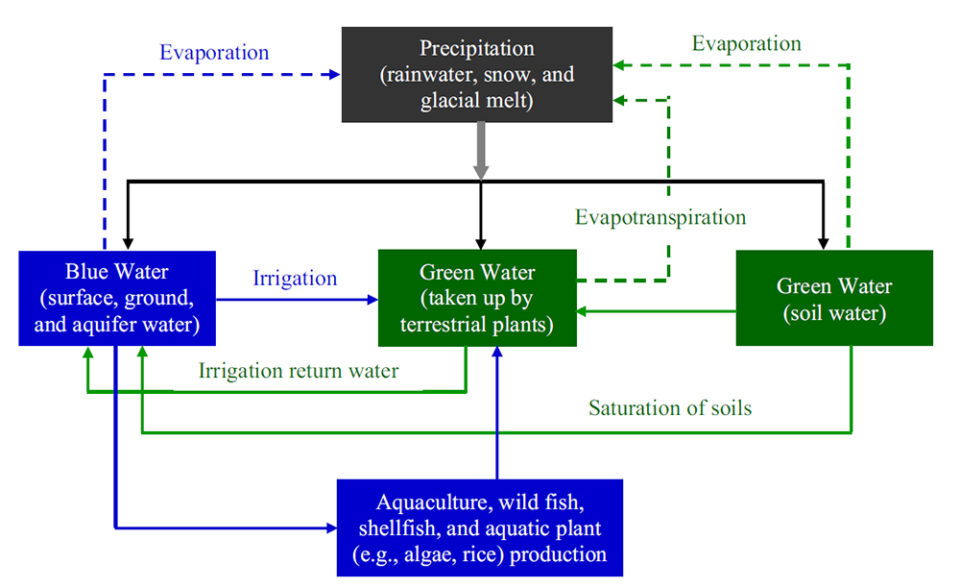Meeting growing demand for food will require environmentally sound practices and sustainable resource management

Aquaculture has been responsible for the growth in supply of fish for human consumption. In order to meet the demand for food for a growing global population, aquaculture production must be increased to fill the gap between supply and demand with rapidly expanding global fish demand and relatively stable capture fisheries.
Global capture fisheries production has been stagnated since the late 1980s, reaching 90.9 million metric tons (MT) in 2016. Because of increasing population, global aquaculture production is projected to reach 109 million MT in 2030, with a growth of 37 percent over 2016 (FAO, 2018). But the long-term growth of the aquaculture industry needs both environmentally sound practices and sustainable resource management.
This article – summarized and adapted from the original publication (Science of the Total Environment 652 (2019) 851–861; https://doi.org/10.1016/j.scitotenv.2018.10.163) – reviews global aquaculture production in terms of its development, farming systems, environmental concernsand further growth potential while focusing on aquaculture’s effect on water (e.g., surface and groundwater) use, environmental impacts and growth potential.
This study was supported by the Natural Resources Institute (NRI), University of Manitoba, Canada. We thank four anonymous reviewers for their helpful comments and suggestions.

The ‘blue revolution’
Aquaculture has been practiced for millennia, having a long and rich history in ancient China, Egypt, and Rome. Aquaculture started around 4,000 years ago during the period 2000–1000 BCE in China. After World War II, aquaculture received attention and became a commercial practice in Asia during the 1960s. Since then, global aquaculture has significantly developed towards diversification and intensification.
This rapid development of aquaculture, or the “blue revolution,” refers to the significant emergence of aquaculture as a vital and very productive agricultural activity. The blue revolution is the result of huge fish production that contributes to human nutrition in similar ways to the “green revolution.” The blue revolution of aquaculture is becoming increasingly an attractive approach to enhance food production. In fact, aquaculture is increasing food production and contributing to human nutrition and food security.
Globally, fish provide about 3.2 billion people with 20 percent of their animal protein intake, and per capita fish consumption has increased from 9 kg in 1961 to 20.3 kg in 2016 (FAO, 2018). Global aquaculture production (excluding aquatic plants) increased six-fold between 1990 and 2016, resulting in production by aquaculture becoming nearly equal to wild caught fisheries production. Compared to capture fisheries, the contribution of aquaculture to the world fish production (capture and culture) has increased from 26 percent in 2000 to 47 percent in 2016 (FAO, 2018).
Small-scale freshwater rural aquaculture contributes to food security, poverty alleviation and socioeconomic benefits in many countries. Integrated Aquaculture-Agriculture (IAA) systems, including pond-dike cropping and rice-fish culture, are practiced in some Asian and African countries for maximizing benefits from land, water and labor to increase productivity, profitability and sustainability. Open-water aquaculture, including cage culture, floodplain aquaculture, pen culture and culture-based fisheries, has significantly developed in Southeast Asian countries. Biofiltration systems including aquaponics and recirculating aquaculture systems (RAS) that have become popular in recent years.
Globally, coastal aquaculture including shrimp farming expanded rapidly in the 1980s and 1990s, mostly in the tropical and subtropical regions of Asia and South America, driven by growing international demand and high market prices. Mariculture mainly involves high-value species, including barramundi, salmon, sea bass, sea bream and trout with bivalve mollusks (e.g., clams, mussels, oysters and scallops) and seaweeds. Commercial salmon production is significant in Canada, Chile, Norway and Scotland. Mollusk and seaweed farming are environmentally friendly due to reducing nutrient-pollution. Integrated Multi-Trophic Aquaculture (IMTA) – a process of growing finfish (fed-fish), shellfish (organic extractive species) and seaweeds (inorganic extractive species) from different trophic levels in an integrated farm to create balanced environment for economic viability – is also environmentally friendly.

Blue water aquaculture
There are two types of water utilization in food production: (1) blue water and (2) green water (Fig. 2). Green water refers to soil water, which is formed by rainfall and consumed by plants for biomass production. Green water also denotes precipitation that is stored as soil moisture. About 60 percent of rainfall turns into green water, which does not reach a river or aquifer. Over 85 percent of green water is consumed by plants in agriculture. Globally, most food is produced from green water and the amount of green water utilization in global food production is four to five times higher than consumptive use of blue water.
Rainfall that does not absorb into the soil is blue water. Blue water implies groundwater and surface runoff in lakes, ponds and rivers that can be withdrawn for irrigation and human utilization. Globally, 39 percent of rainfall contributes to blue water, of which 36 percent goes to the seas and oceans. Thus, water in aquifers, seas and oceans is also known as blue water. Aquaculture primarily depends on blue water due to the availability of surface and groundwater. Access to blue water is vital for aquaculture, as significant volumes of water are required to grow fish.
Utilizing blue water in ponds for inland freshwater aquaculture is significant. Irrigation return water is also applied for aquaculture, which is known as integrated irrigation aquaculture (IIA). There is a substantial contribution of IIA where fish farms have access to irrigation return water from canals and tributaries. Cage culture, floodplain aquaculture and pen culture are also important for using blue water resources.
Green water also plays an important role in IAA as rainfed green water is suitable for rice-fish farming. Green water is also necessary for dike cropping in pond-based IAA as terrestrial ecosystems fully depend on green water. The utilization of blue and green water in integrated mangrove-shrimp cultivation is also significant. In fact, blue water cannot be separated from green water in integrated farming as they are complementary to each other.
The efficient use of blue water in aquaculture can reduce water utilization. IAA is a water efficient farming system, which is recognized as “more crop per drop.” Moreover, using blue water in aquaponics and RAS are water-efficient production techniques, which filter and clean the water for recycling back to fish tanks. The further expansion of environmentally friendly coastal and marine aquaculture could also help release pressure on increasingly scarce freshwater resources.
The blue frontiers
Aquaculture is associated with a wide range of environmental concerns, which are known as blue frontiers. These environmental concerns need to be addressed for its sustainable development. With the widespread conversion of lands to ponds, detrimental environmental effects of aquaculture occur.
The rapid growth of aquaculture with poor water quality is a major concern of disease outbreaks for many farmed species. The use of various antibiotics, chemicals and medicinal drugs in intensive aquaculture can cause water pollution, leading to imbalances in aquatic ecosystems. Overstocking and overfeeding fish ponds can produce high organic matter and fish waste that affect water quality and reduce dissolved oxygen concentration through decomposition of waste feed and fish feces. Effluent discharged from fish farms may also have negative effects on local water resources. Cage and net-pen aquaculture releases untreated nutrients and chemicals into open-water environment.
Aquaculture must take an ecosystem approach to reduce the environmental effects of the blue revolution. To avoid environmental hazards in aquaculture, sustainable intensification with efficient use of land and water, technological developments, better management practices, better site selection within the carrying capacity of ecosystems, and an ecosystem approach to aquaculture must be followed. Fish producers need to understand and comply with environmental regulations through these concepts.
Blue carbon emissions
Blue carbon is the organic carbon sequestered, stored and released from coastal and marine ecosystems, including salt marshes, seagrasses and mangrove swamps. Mangroves are the most carbon-rich forests and store three to four times more carbon than tropical upland forests. Globally, 10.8 billion tons of blue carbon are stored in mangrove forests. Mangroves store blue carbon in soils, living biomass and non-living biomass, with an average of 858 tons per hectare. Although mangroves can grow up to 40 meters in height, more than 80 percent of the mangroves’ blue carbon stock is in the soils.
Global mangrove area accounts for 16.39 million hectares within 105 countries. Southeast Asia contains 33.8 percent of the global mangrove forests and the top 20 mangrove nations contain 80 to 85 percent of the global mangrove forests. However, mangrove forests are one of the world’s most threatened ecosystems. Globally, mangroves have suffered a 30 to 50 percent deforestation over the past 50 years.
Preventing mangrove loss and the conservation of mangrove forests can help to reduce blue carbon emissions for climate change mitigation. Mangrove restoration and conservation could increase blue carbon sequestration. Mangrove restoration could increase resilience to climate change by providing protection from coastal flooding, cyclones, shoreline erosion, saltwater intrusion and tidal surges. Mangrove restoration and conservation could provide climate regulation, coastal protection, biodiversity conservation and fisheries production.
A blue economy
The concept of the blue economy came out of the 2012 United Nations Conference on Sustainable Development – or Rio+20 conference – which focused on sustainable development including ocean-based economies. The blue economy refers to the use of oceans, seas and coastal resources for sustainable economic development through ecosystem integrity. The blue economy is low-carbon with resource efficiency, which offers a wide range of opportunities for sustainable, clean and equitable blue growth in traditional and emerging sectors. The blue economy involves the sustainable development of aquaculture, fisheries, tourism, maritime transport, marine biotechnology, seabed mining and renewable energy. A sustainable marine-based economy could provide socioeconomic benefits for current and future generations, by contributing to food security, livelihood opportunities, income, poverty alleviation, health, safety, equity and political stability.
In 2013, the Food and Agriculture Organization of the United Nations launched the blue growth initiative from oceans, seas and coasts, which focuses on ecosystem-based aquaculture and fisheries with efficient use of resources, reducing carbon footprints, employment opportunities, social protection and decent work conditions (FAO, 2018). Aquaculture and fisheries can be vital in the transition towards a blue economy as both are interconnected with and rely on aquatic ecosystems. Aquaculture under the blue economy should incorporate the value of the natural capital for its sustainable development towards food security, income and sustainable livelihoods. The further development of the blue economy of coastal and marine aquaculture could provide a wide range of social, economic and environmental benefits.
Perspectives
The blue revolution of aquaculture has increased global fish production in order to contribute to human nutrition and food security. The use of blue water in aquaculture also makes a significant contribution to global fish production. But to meet the demand for food from a growing global population, aquaculture production must increase sustainably while at the same time reducing its environmental impacts. Producing fish in an environmentally sustainable way is essential. Innovative farming systems are also required for adaptation to climate change. Integrated mangrove-shrimp cultivation with reduced deforestation and forest degradation can help reduce blue carbon emissions through mangrove restoration and conservation. To grow the blue economy of coastal and marine aquaculture, seafood production must be increased through the efficient use of brackish water and sea water, through mollusk farming, seaweed production and integrated multi-trophic aquaculture technology.
Empirical research is essential to understand interlinked processes for the expansion of blue water aquaculture towards blue growth potential. To create a sustainable blue economy of coastal and marine aquaculture, key stakeholders including international agencies, researchers, policymakers, government and non-governmental organizations, and local communities must work together to achieve social, economic and ecological benefits.
References available at the original publication.
Now that you've finished reading the article ...
… we hope you’ll consider supporting our mission to document the evolution of the global aquaculture industry and share our vast network of contributors’ expansive knowledge every week.
By becoming a Global Seafood Alliance member, you’re ensuring that all of the pre-competitive work we do through member benefits, resources and events can continue. Individual membership costs just $50 a year. GSA individual and corporate members receive complimentary access to a series of GOAL virtual events beginning in April. Join now.
Not a GSA member? Join us.
Authors
-
Nesar Ahmed, Ph.D.
Research Associate
Natural Resources Institute
University of Manitoba
Winnipeg, Manitoba R3T 2M6, Canada[97,99,46,97,98,111,116,105,110,97,109,117,64,100,101,109,104,97,46,114,97,115,101,110]
-
Shirley Thompson, Ph.D.
Associate Professor
Natural Resources Institute
University of Manitoba
Winnipeg, Manitoba R3T 2M6, Canada
Tagged With
Related Posts

Responsibility
Can sustainable mariculture match agriculture’s output?
Global, sustainable mariculture production, developed on a massive, sustainable scale and using just a small fraction of the world’s oceanic areas, could eventually match the output of land-based agriculture production. Scale and international law considerations require the involvement of many stakeholders, including national governments and international organizations.

Responsibility
Sea cucumbers enhance IMTA system with abalone, kelp in China
In the authors’ recent study, sea cucumbers were added directly to abalone cages with no modifications of the culture equipment to form a simple, low-cost IMTA production system.

Innovation & Investment
Investing in Africa’s aquaculture future, part 1
What is the future that Africa wants? Views on how to grow aquaculture on the continent vary widely, but no one disputes the notion that food security, food safety, income generation and job creation all stand to benefit.

Innovation & Investment
At Aquaculture America 2018, signs of support for thriving domestic industry
Aquaculture must reshape its public narrative in order for the blue revolution to transpire. That’s what many prominent voices were saying at the World Aquaculture Society’s annual U.S. conference in Las Vegas.


